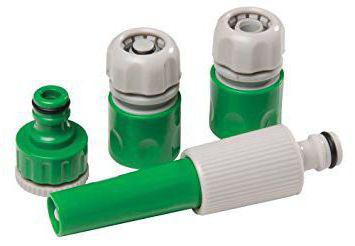A hose connector is a quick-detachable connection necessary for ease of operation of irrigation equipment when irrigating a site or when using it in portable car washes. A feature of modern connectors is that they withstand high pressure in the pipe without additional waterproofing. Such items are easy to install and easy to use.
Varieties of hose connectors
All quick-detachable connections have a common feature - the presence of an outlet under the nipple connecting it to the adapter on the tap, sprinkler or spray gun.
The hose connector can be made of plastic or metal alloy. The composition of the material depends on the working pressure in the pipe. Plastic joints of the middle price segment withstand about 10-15 bar. Metal and brass products are designed to operate under pressure in the pipe above 15-20 bar.
Often, the word "connector" means a sleeve with which two watering hoses of equal or different diameters are connected. In this case, it should be borne in mind that the coupling is really designed to connect two hoses, however, in order to then disconnect them, you will need to unscrew the cap and pull out the pipe.
The threaded connecting nozzle is designed for use with other elements similar in design. Depending on the details of the bundle, an external or internal thread of a certain diameter may be required. Such connections are also connected to the nipple and can be quickly pulled out.
What does it consist of?
A classic hose connector consists of the following elements:
- Tube holder with housing. A watering hose is inserted directly into it. After tightening the cover, it tightly and tightly fastens inside the connector.
- Latching mechanism. It is he who provides the ability to remove the device in one motion.
- Screw cap. With it, the hose is fixed in the connector. It has an internal thread that is screwed onto the tube holder. As a result, the structure is fixed, compression is provided.
- Stop valve. Installed in connectors with automatic closure. It is a plastic or metal piston with rubber glands providing tightness. The essence of his work is that when the connector is connected to the nipple, the latter presses on the piston. In the connected state, the valve is always open, and after disconnection, the pressure in the pipe closes it. This allows you to stop the flow of water without turning off the tap.
- Rubber bands for sealing. They are located inside the quick connection and do not allow water to escape through the thread.
Standard sizes
All connectors are designed for hoses of standard diameter and are produced according to certain parameters. Universal adapters can connect tubes of different diameters, but in the domestic market these connections are extremely rare.
- Connector for 3/4 "hose. Using it, quickly connect flexible pipes with a diameter of 3/4 inch or 19 mm.
- The device with a diameter of 1 inch is designed for a hose of 25-26 mm in cross section.
- 1/2 "hose connector. It is used for pipes with a diameter of 12-13 mm.
- More rare 1/4, 3/8 and 5/8 inches are designed to fit the appropriate hose sizes.
Application area
The hose connector is used wherever there is a need to use the water supplied from the hose.
The most widespread use of quick connections when watering personal plots, lawns and flower beds, connecting to car wash equipment.
When choosing the material and size of the adapter, the following factors must be considered:
- Working pressure in the pipe.
- Flexible tube diameter and nipple size.
- Weather conditions at the time of use.
- The possibility of mechanical damage to fittings for irrigation.
Other watering fittings
The connector for the irrigation hose is just one of the elements of the connecting fittings for irrigation. For its successful operation, other parts are required.
- Nipple. It is a cone connecting two connectors. At its ends are gum, ensuring the tightness of the connection. This element can be of two types: STANDARD and POWER JET. Depending on this, a quick connection is selected. Two elements of such reinforcement cannot be fastened with parts of different sizes.
- Tee. It is an analogue of the nipple. The difference is that it has three connections to the connector.
- Coupling. Connects two flexible tubes. If the element is reducing, then with its help it is possible to connect hoses of various diameters.
- The adapter on the crane. This device is designed to connect a hose to the water supply. Depending on the thread of the valve, it may have an external or internal thread. At the other end is a nipple connector.
- Pistols and sprinklers. There are a huge number of irrigators of various modifications. At the end they have a nipple connector suitable for the connector.

All elements of watering connecting fittings are necessary to ensure ease of use. A variety of sizes and shapes allows you to choose the elements that provide high-quality watering in each specific situation.